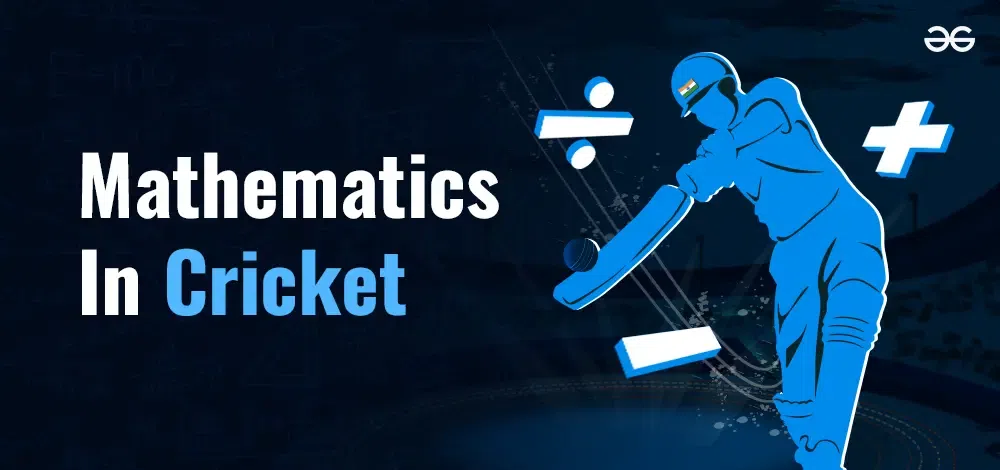Real Life Application of Maths in Cricket
Last Updated :
05 Apr, 2024
Maths in Cricket: Cricket is often praised for its beauty and skill, but it really relies on smart planning and thoughtful decisions. Cricket fans love big hits and great catches, but math is important in every aspect of the game, like the captain’s plans and how players are doing. Cricket fans enjoy great catches and big hits but math is important in every part of the game like the captain’s plans and how players are doing individually.

Applications of Mathematics in Cricket
Cricket involves more than just hitting balls and trying to score points. In this complex game, it is important to think carefully and make smart choices. This is how math plays a big role in cricket:
Various application of Math in Cricket are:
- Strategic Decision-Making
- Rain Disruptions and DLS Method
- Player Performance Analysis
- Determining Batting Order
- Fantasy Cricket
- Enhancing Training Plans
Let’s learn about the same in detail.
Strategic Decision-Making
Captains make decisions that can decide if their team wins or loses. This is when their math skills are important.
- Run Rate Calculations: Deciding how fast a team needs to score runs is important whether they are chasing a target or setting one. Captains use formulas that consider how good their team is at batting, how many overs are left, and how many wickets they have.
For example, if a team has seven wickets left and needs to score 150 runs in 18 overs, the captain might calculate a required run rate of 8.33 runs per over (150 runs/18 overs) and adjust it based on the skills of the batsmen and the situation of the game.
- Field Placement: Good field positions are very important for bowling plans to work well. Captains think about where to put fielders based on how the bowler bowls, how the batsman plays, and what is happening in the game. They often use geometry to figure out the best spots.
For example, a captain might put a fielder at deep square leg to stop a batsman who likes to play the pull shot.
Rain Disruptions and DLS Method
In cricket, bad weather can affect matches and sometimes make them finish early. When this happens, the Duckworth-Lewis Method (DLS) is used. It was created by two statisticians, Tony Lewis and Frank Duckworth, to help decide a new target for the team batting second. The method considers factors like how many overs were lost, how many wickets the team batting first lost, and the difference in score between the two teams.
Player Performance Analysis
In modern cricket, analyzing data is important for evaluating how well players perform. Teams have experts who use different statistics to understand a player’s strengths and weaknesses.
Some of these statistics include:
- Batting Averages: A batsman’s average is calculated by dividing their total runs by the number of times they were dismissed (excluding not-outs). A higher average indicates more consistency in scoring runs.
- Strike Rate: This measure shows how many runs a batter scores for every 100 balls they face. It tells us if the batter takes risks or plays aggressively.
- Bowling Economy Rate: This is how many runs a bowler typically concedes in one over. Bowlers with lower economy rates are more economical.
Determining Batting Order
Deciding the batting order isn’t just about who’s been on the team the longest—it’s like solving a puzzle using math! Teams think about each player’s strengths, weaknesses, and how they’ve done against the other team before.
By doing some math magic, teams figure out how many runs they need to score and how fast they need to score them. They then create a batting order that makes sure they reach that score by the end of their turn to bat
Player Performance Analysis
Performance of any player not only includes the runs scores by him, and wicket taken by him, but it also includes how an player perform under various condition and in stress. Math is used to analyze performance of players over time, identify trends, strengths, and weaknesses, and make informed selections for teams and tournaments.
Fantasy Cricket
Fantasy cricket is a popular game where players create virtual teams and compete. To win, it is important to pick players with good statistics like runs, wickets, and catches. Gamers choose players based on past performance, current form, and set criteria to score points.
Enhancing Training Plans
Modern cricket training uses math to improve player performance. By analyzing factors like fitness, batting style, and bowling speed, trainers can design better training plans. This data-driven approach helps players improve their skills more effectively.
FAQs on Applications of Mathematics in cricket
Is cricket all about math?
Even though math is important for strategy and analysis in cricket, the game is mostly about physical skill, mental strategy, and luck. Math doesn’t replace the human element. it just makes the game better.
Are there any complex mathematical concepts used in cricket?
Math in cricket is mainly about averages, percentages, and basic calculations. But, advanced analysis can include things like data modeling and probability theory.
How can I improve my understanding of math in cricket?
You can learn about how cricket uses statistics and data analysis from many online sources and websites about the sport. Watching cricket commentators can also help, as they explain why they make certain judgements.
Does using math guarantee success in cricket?
Having a good understanding of math can be helpful, but it is not the only thing that guarantees success. Other factors like a player’s background and team also play a big role.
Share your thoughts in the comments
Please Login to comment...